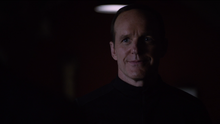No edit summary Tag: Visual edit |
No edit summary |
||
| Line 2: | Line 2: | ||
{{Item |
{{Item |
||
|image = B.A.R.F.png |
|image = B.A.R.F.png |
||
| − | |creator = [[Quentin Beck]] |
+ | |creator = [[Quentin Beck]] † |
|made = [[2016]] |
|made = [[2016]] |
||
|owners = [[Stark Industries]] |
|owners = [[Stark Industries]] |
||
Revision as of 22:54, 20 July 2019
- "Binarily Augmented Retro-Framing, or B.A.R.F. – God, I gotta work on that acronym. An extremely costly method of hijacking the hippocampus... to clear traumatic memories."
- ―Tony Stark[src]
Binarily Augmented Retro-Framing, better known by its acronym B.A.R.F., is a prototype technology designed by Quentin Beck, using a holographic illusion system. Despite its potential, B.A.R.F. was used by Tony Stark for therapeutic pursuits.
History
2016 MIT Presentation
- "A revolutionary breakthrough with limitless applications, which Tony turned into a self-therapy machine and renamed... He renamed my life's work "B.A.R.F.", then he fired me, saying I was unstable."
- ―Quentin Beck[src]
Working for Stark Industries, Quentin Beck designed a holographic system that could be innovative. However, Tony Stark decided to use Beck's system for therapeutic pursuits and remade it into the Binarily Augmented Retro-Framing, codenamed B.A.R.F., much to Beck's displeasure.[1]
While giving a presentation at the Massachusetts Institute of Technology, Stark used B.A.R.F. to revisit the memory of seeing Howard and Maria Stark alive for the last time. Stark later explained to the assembled students that he felt guilty for the lack of respect and compassion he showed his parents in their last conversation.[2]
Quentin Beck's Campaign
In 2024, Quentin Beck, furious that he was discredited of his work, used the Binarily Augmented Retro-Framing framework to feign several Elemental crises across the globe, successfully initiating attacks in Mexico and Morocco. He also used them later in Europe, but Beck was defeated by Spider-Man when he discovered his fraudulence.[1]
Capabilities
| This section requires expansion |
The B.A.R.F. relies on a complex holographic system that connects with the user's hippocampus, allowing it to find a certain traumatic memory and alter it before projecting that memory onto an external infrastructure. Through the altered projection, the user is able to successfully re-experience and hopefully work through overcoming traumatic experiences.[2]

